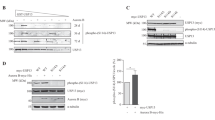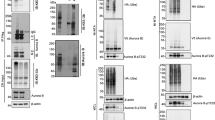Abstract
Overexpression of Aurora-A oncogene has been shown to induce genomic instability and tumorigenesis. Cellular levels of Aurora-A are regulated by multiple mechanisms including the proteasome-dependent degradation of Aurora-A protein. Cell-cycle-dependent turnover of Aurora-A protein is mediated by cdh1 through ubiquitin (Ub)- and proteasome-dependent pathway. However, Aurora-A kinase interacting protein 1 (AURKAIP1), a negative regulator of Aurora-A, also promotes proteasome-dependent Aurora-A degradation through an Ub-independent mechanism. In an attempt to understand how AURKAIP1 promotes Aurora-A degradation through Ub-independent pathway, we demonstrate here that antizyme1 (Az1), a well-studied mediator of Ub-independent protein degradation pathway, regulates Aurora-A protein stability. We show that ectopic or polyamine-induced expression of Az1 can lower the steady-state levels of Aurora-A. The effect of Az1 on Aurora-A turnover was shown to be proteasome-dependent, but Ub-independent. Az1 interacts with Aurora-A in vivo and the interaction between Aurora-A and Az1 is essential for the Az1-mediated Aurora-A degradation. Furthermore, we observed that AURKAIP1 could not promote degradation of Aurora-A mutant, which is defective in Az1 interaction. Coexpression of the Az inhibitor (AzI), which downregulates Az1 functions, also abrogated AURKAIP1-mediated degradation of Aurora-A. We further demonstrated that AURKAIP1, Az1 and Aurora-A could exist as a ternary complex and AURKAIP1 enhances the interaction between Az1 and Aurora-A. We propose that AURKAIP1 might function upstream of the Az1 by enhancing the binding affinity of Az1 to Aurora-A to promote recognition, targeting to proteasome and subsequent degradation.
This is a preview of subscription content, access via your institution
Access options
Subscribe to this journal
Receive 50 print issues and online access
$259.00 per year
only $5.18 per issue
Buy this article
- Purchase on Springer Link
- Instant access to full article PDF
Prices may be subject to local taxes which are calculated during checkout





Similar content being viewed by others
References
Asher G, Tsevetkov P, Kahana C, Shaul Y . (2005). A mechanism of ubiquitin-independent proteasomal degradation of the tumor suppressors p53 and p73. Genes Dev 19: 316–321.
Bercovich Z, Rosenberg-Hasson Y, Ciechanover A, Kahana C . (1989). Degradation of ornithine decarboxylase in reticulocyte lysate is ATP-dependent but ubiquitin-independent J. Biol Chem 264: 15949–15952.
Bischoff JR, Anderson L, Zhu Y, Mossie K, Ng L, Souza B et al. (1998). A homologue of Drosophila aurora kinase is oncogenic and amplified in human colorectal cancers. EMBO J 17: 3052–3065.
Buschhorn HM, Klein RR, Chambers SM, Hardy MC, Green S, Bearss D et al. (2005). Aurora-A over-expression in high-grade PIN lesions and prostate cancer. Prostate 64: 341–346.
Chen H, MacDonald A, Coffino P . (2002). Structural elements of antizymes 1 and 2 are required for proteasomal degradation of ornithine decarboxylase. J Biol Chem 277: 45957–45961.
Coffino P . (2001). Regulation of cellular polyamines by antizyme. Nature Rev 2: 188–194.
Crane R, Klofper A, Ruderman JV . (2004). Requirements for the destruction of human Aurora-A. J Cell Sci 117: 5975–5983.
Feith DJ, Shantz LM, Pegg AE . (2001). Targeted antizyme expression in the skin of transgenic mice reduces tumor promoter induction of ornithine decarboxylase and decreases sensitivity to chemical carcinogenesis. Cancer Res 61: 6073–6081.
Fong LY, Feith DJ, Pegg AE . (2003). Antizyme overexpression in transgenic mice reduces cell proliferation, increases apoptosis, and reduces N-nitroso methyl-benzylamine-induced forestomach carcinogenesis. Cancer Res 63: 3945–3954.
Gandre S, Bercovich Z, Kahana C . (2002). Ornithine decarboxylase-antizyme is rapidly degraded through a mechanism that requires functional ubiquitin-dependent proteolytic activity. Eur J Biochem 269: 1316–1322.
Gardini G, Cravanzola C, Autelli R, Testore G, Cesa R, Morando L et al. (2003). Agmatine inhibits the proliferation of rat hepatoma cells by modulation of polyamine metabolism. J Hepatol 39: 793–799.
Gerner EW, Meyskens Jr FL . (2004). Polyamines and cancer: old molecules, new understanding. Nat Rev Cancer 4: 781–792.
Glass JR, Gerner EW . (1987). Spermidine mediates degradation of ornithine decarboxylase by a non-lysosomal, ubiquitin-independent mechanism. J Cell Physiol 130: 133–141.
Gritsko TM, Coppola D, Paciga JE, Yang L, Sun M, Shelley SA et al. (2003). Activation and overexpression of centrosome kinase BTAK/Aurora-A in human ovarian cancer. Clin Cancer Res 9: 1420–1426.
Hoffman DW, Carroll D, Martinez N, Hackert ML . (2005). Solution structure of a conserved domain of antizyme: a protein regulator of polyamines. Biochemistry 44: 11777–11785.
Honda K, Mihara H, Kato Y, Yamaguchi A, Tanaka H, Yasuda H et al. (2000). Degradation of human Aurora2 protein kinase by the anaphase-promoting complex-ubiquitin-proteasome pathway. Oncogene 19: 2812–2819.
Ivanov IP, Gesteland RF, Atkins JF . (2000). Antizyme expression: a subversion of triplet decoding, which is remarkably conserved by evolution, is a sensor for an autoregulatory circuit. Nucleic Acid Res 28: 3185–3196.
Iwata S, Sato Y, Asada M, Takagi M, Tsujimoto A, Inaba T et al. (1999). Anti-tumor activity of antizyme which targets the ornithine decarboxylase (ODC) required for cell growth and transformation. Oncogene 18: 165–172.
Jin Y, Lee H, Zeng SX, Dai MS, Lu H . (2003). MDM2 promotes p21waf1/cip1 proteasomal turnover independently of ubiquitylation. EMBO J 22: 6365–6377.
Kiat LS, Hui KM, Gopalan G . (2002). Aurora-A kinase interacting protein (AIP), a novel negative regulator of human Aurora-A kinase. J Biol Chem 277: 45558–45565.
Koike C, Chao DT, Zetter BR . (1999). Sensitivity to polyamine-induced growth arrest correlates with antizyme induction in prostate carcinoma cells. Cancer Res 59: 6109–6112.
Li D, Zhu J, Firozi PF, Abbruzzese JL, Evans DB, Cleary K et al. (2003). Overexpression of oncogenic STK15/BTAK/Aurora A kinase in human pancreatic cancer. Clin Cancer Res 9: 991–997.
Li X, Coffino P . (1992). Regulated degradation of ornithine decarboxylase requires interaction with the polyamine-inducible protein antizyme. Mol Cell Biol 12: 3556–3562.
Li X, Coffino P . (1993). Degradation of ornithine decarboxylase: exposure of the C-terminal target by a polyamine-inducible inhibitory protein. Mol Cell Biol 13: 2377–2383.
Lim SK, Gopalan G . (2007). Aurora-A kinase interacting protein 1 (AURKAIP1) promotes Aurora-a degradation through alternative ubiquitin-independent pathway. Biochem J 403: 119–127.
Lin Y, Martin J, Gruendler C, Farley J, Meng X, Li BY et al. (2002). A novel link between the proteasome pathway and the signal transduction pathway of the bone morphogenetic proteins (BMPs). BMC Cell Biol 3: 15.
Littlepage LE, Ruderman JV . (2002). Identification of a new APC/C recognition domain, the A box, which is required for the Cdh1-dependent destruction of the kinase Aurora-A during mitotic exit. Genes Dev 16: 2274–2285.
Mangold U . (2006). Antizyme inhibitor: mysterious modulator of cell proliferation. Cell Mol Life Sci 63: 2095–2101.
Mao JH, Perez-Losada J, Wu D, Delrosario R, Tsunematsu R, Nakayama KI et al. (2004). Fbxw7/Cdc4 is a p53-dependent, haploinsufficient tumour suppressor gene. Nature 432: 775–779.
Murakami Y, Matsufuji S, Kameji T, Hayashi S, Igarashi K, Tamura T et al. (1992). Ornithine decarboxylase is degraded by the 26S proteasome without ubiquitination. Nature 360: 597–599.
Newman RM, Mobascher A, Mangold U, Koike C, Diah S, Schmidt M et al. (2004). Antizyme targets cyclin D1 for degradation. A novel mechanism for cell growth repression. J Biol Chem 279: 41504–41511.
Rom E, Kahana C . (1994). Polyamines regulate the expression of ornithine decarboxylase antizyme in vitro by inducing ribosomal frame-shifting. Proc Natl Acad Sci USA 91: 3959–3963.
Rosenberg-Hasson Y, Bercovich Z, Ciechanover A, Kahana C . (1989). Degradation of ornithine decarboxylase in mammalian cells is ATP dependent but ubiquitin independent. Eur J Biochem 185: 469–474.
Sakakura C, Hagiwara A, Yasuoka R, Fujita Y, Nakanishi M, Masuda K et al. (2001). Tumour-amplified kinase BTAK is amplified and overexpressed in gastric cancers with possible involvement in aneuploid formation. Br J Cancer 84: 824–831.
Satriano J, Matsufuji S, Murakami Y, Lortie MJ, Schwartz D, Kelly CJ . (1998). Agmatine suppresses proliferation by frameshift induction of antizyme and attenuation of cellular polyamine levels. J Biol Chem 273: 15313–15315.
Sdek P, Ying H, Chang DLF, Qiu W, Zheng H, Touitou R et al. (2005). MDM2 promotes proteasome-dependent ubiquitin-independent degradation of retinoblastoma protein. Mol Cell 20: 699–708.
Strous GJ, van Kerkhof P, Govers R, Ciechanover A, Schwartz AL . (1996). The ubiquitin conjugation system is required for ligand-induced endocytosis and degradation of the growth hormone receptor. EMBO J 15: 3806–3812.
Taguchi S, Honda K, Sugiura K, Yamaguchi A, Furukawa K, Urano T . (2002). Degradation of human Aurora-A protein kinase is mediated by hCdh1. FEBS Lett 519: 59–65.
Tanaka T, Kimura M, Matsunaga K, Fukada D, Mori H, Okano Y . (1999). Centrosomal kinase AIK1 is overexpressed in invasive ductal carcinoma of the breast. Cancer Res 59: 2041–2044.
Walter AO, Seghezzi W, Korver W, Sheung J, Lees E . (2000). The mitotic serine/threonine kinase Aurora2/AIK is regulated by phosphorylation and degradation. Oncogene 19: 4906–4916.
Yu X, Minter-Dykhouse K, Malureanu LZhao WM, Zhang D, Merkle CJ, Ward IM et al. (2005). Chfr is required for tumor suppression and Aurora A regulation. Nat Genet 37: 401–406.
Zhang M, Pickart CM, Coffino P . (2003). Determinants of proteasome recognition of ornithine decarboxylase, a ubiquitin-independent substrate. EMBO J 22: 1488–1496.
Zhou H, Kuang J, Zhong L, Kuo WL, Gray JW, Sahin A et al. (1998). Tumour amplified kinase STK15/BTAK induces centrosome amplification, aneuploidy and transformation. Nat Genet 20: 189–193.
Acknowledgements
We thank Dr Ger J Strous and Dr Issacs for providing us the ts20-CHO and AT2.1 rat prostate carcinoma cell lines, respectively. We also thank Dr Geisen, Dr Coffino and Dr Prochownik for the p27kip1, mouse ODC and cyclinB1 expression plasmids, respectively. We acknowledge the generosity of Dr John Mitchell for the anti-antizyme antibody. This work was supported by the National Medical Research Council of Singapore in the form of a research grant (NMRC/0815/2003) to GG and as Institutional Block Grant to National Cancer Centre, Singapore.
Author information
Authors and Affiliations
Corresponding author
Additional information
Supplementary Information accompanies the paper on the Oncogene website (http://www.nature.com/onc).
Supplementary information
Rights and permissions
About this article
Cite this article
Lim, S., Gopalan, G. Antizyme1 mediates AURKAIP1-dependent degradation of Aurora-A. Oncogene 26, 6593–6603 (2007). https://doi.org/10.1038/sj.onc.1210482
Received:
Revised:
Accepted:
Published:
Issue Date:
DOI: https://doi.org/10.1038/sj.onc.1210482
Keywords
This article is cited by
-
Antizyme inhibitor family: biological and translational research implications
Cell Communication and Signaling (2024)
-
AURKAIP1 actuates tumor progression through stabilizing DDX5 in triple negative breast cancer
Cell Death & Disease (2023)
-
The biguanide polyamine analog verlindamycin promotes differentiation in neuroblastoma via induction of antizyme
Cancer Gene Therapy (2022)
-
Targeting AURKA in Cancer: molecular mechanisms and opportunities for Cancer therapy
Molecular Cancer (2021)
-
Pan-cancer driver copy number alterations identified by joint expression/CNA data analysis
Scientific Reports (2020)



